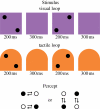Multistability in perception: binding sensory modalities, an overview
- PMID: 22371612
- PMCID: PMC3282306
- DOI: 10.1098/rstb.2011.0254
Multistability in perception: binding sensory modalities, an overview
Abstract
This special issue presents research concerning multistable perception in different sensory modalities. Multistability occurs when a single physical stimulus produces alternations between different subjective percepts. Multistability was first described for vision, where it occurs, for example, when different stimuli are presented to the two eyes or for certain ambiguous figures. It has since been described for other sensory modalities, including audition, touch and olfaction. The key features of multistability are: (i) stimuli have more than one plausible perceptual organization; (ii) these organizations are not compatible with each other. We argue here that most if not all cases of multistability are based on competition in selecting and binding stimulus information. Binding refers to the process whereby the different attributes of objects in the environment, as represented in the sensory array, are bound together within our perceptual systems, to provide a coherent interpretation of the world around us. We argue that multistability can be used as a method for studying binding processes within and across sensory modalities. We emphasize this theme while presenting an outline of the papers in this issue. We end with some thoughts about open directions and avenues for further research.
Figures








References
-
- Blake R. 1989. A neural theory of binocular rivalry. Psychol. Rev. 96, 145–16710.1037/0033-295X.96.1.145 (doi:10.1037/0033-295X.96.1.145) - DOI - DOI - PubMed
-
- Leopold D. A., Logothetis N. K. 1999. Multistable phenomena: changing views in perception. Trends Cogn. Sci. 3, 254–26410.1016/S1364-6613(99)01332-7 (doi:10.1016/S1364-6613(99)01332-7) - DOI - DOI - PubMed
-
- Blake R., Logothetis N. K. 2002. Visual competition. Nat. Rev. Neurosci. 3, 13–2110.1038/nrn701 (doi:10.1038/nrn701) - DOI - DOI - PubMed
-
- Long G. M., Toppino T. C. 2004. Enduring interest in perceptual ambiguity: alternating views of reversible figures. Psychol. Bull. 130, 748–76810.1037/0033-2909.130.5.748 (doi:10.1037/0033-2909.130.5.748) - DOI - DOI - PubMed
-
- Kim C. Y., Blake R. 2005. Psychophysical magic: rendering the visible ‘invisible’. Trends Cogn. Sci. 9, 381–388 . (doi:10.1016/j.tics.2005.06.012) - DOI - PubMed
Publication types
MeSH terms
Grants and funding
LinkOut - more resources
Full Text Sources

